Search results for: 'For'
-
 Roman surgical probe made of bronze
Roman surgical probe made of bronzeThe so-called specillum was standard issue for roman doctors. Similar probes are still in use today. Very fine craftsmanship of an ancient surgical instrument.
Price: on request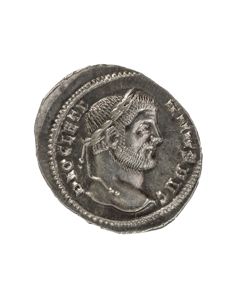 Extremely fine Diocletian argenteus
Extremely fine Diocletian argenteusAbsolutely extremely fine, uncirculated. The RIC states the rarity with R2. In the Occident, Diocletian is (in)famous for the last and largest persecution of Christianity.
Price: on request Roman surgical probe made of silver
Roman surgical probe made of silverThe so-called specillum was standard issue for roman doctors. Similar probes are still in use today. Ancient surgical instruments made of silver are extremely rare.
Price: on request Very fine Nero Aureus
Very fine Nero AureusThis coin type celebrates the failing of the "Pisonian Conspiracy" and emphasizes the divine protection for emperor Nero. Impressive portrait, condition slightly better than very fine.
Price: on request Roman specillum
Roman specillumThe so-called specillum is a surgical probe. It was standard issue for roman doctors. Similar probes are still in use today. 1st to 4th cent. AD.
Price: on request Group of 3 Scythian-Greek arrow heads
Group of 3 Scythian-Greek arrow headsCharacteristically shaped ancient bronze arrow heads. With three wings and barbed hooks. Perfect condition with lovely patina. Typical for the Scythians from 700 BC to hellenistic times.
Price: on request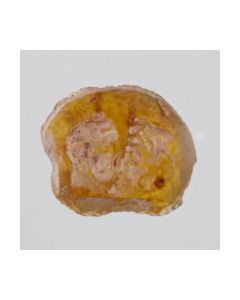 Roman intaglio with two facing heads
Roman intaglio with two facing headsThis special motive for Roman engraved gems often featured two Roman citizens or man and wife. It is an interesting example of its kind made from beautiful orange glass.
Price: on request Base plate of a Roman mirror
Base plate of a Roman mirrorPerfectly preserved bronze plate of a Roman mirror. A handle and reflective metal coating were once part of the object. Typical for upper class Roman households during Imperial times.
€295 Roman oil lamp showing emperor Claudius
Roman oil lamp showing emperor ClaudiusVery rare depiction of this Roman emperor on a piece of pottery intended for daily use. Very well preserved, worth the exhibition in a museum. Coming with an Art Loss certificate.
Price: on request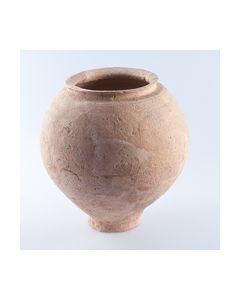 Mittelgroße römische Graburne
Mittelgroße römische GraburneHellrote Keramik, gut restauriert. Beeindruckendes Objekt.
Price: on request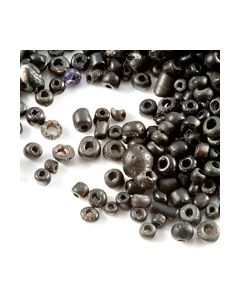 Restbestand - ca 130 römische Perlen aus schwarzem Glas
Restbestand - ca 130 römische Perlen aus schwarzem GlasKunstvoll gearbeitete Perlen aus schwarzem Glas mit Ritzdekor. 3. - 4. Jh. n. Chr., Kaiserzeit - Spätantike.
Price: on request Base plate of a Roman mirror
Base plate of a Roman mirrorThe bronze disc is the base plate of a Roman mirror. A handle and reflective metal coating were once part of the mirror. Typical for upper class Roman households during Imperial times.
Price: on request Colorful Roman glass balsamarium
Colorful Roman glass balsamariumThe small flask was probably used for perfume or other scented oils. This type of vessel was used throughout the Roman trade markets. The play of colours on the surface is wonderful.
Price: on request Lekythos from Toledo Museum collection
Lekythos from Toledo Museum collectionEx collection Prof. G. Olcott, the first Columbia University professor for Roman archeology. Acquired from his estate 1912 by the Toledo Museum (Ohio), in the museum collection until 2017. Found in Apulia.
Price: on request Greek skyphos: Italic imitation of Proto-Corinthian or Laconian pottery
Greek skyphos: Italic imitation of Proto-Corinthian or Laconian potteryAbout late 7th - 6th century B.C. From the Austrian collection of Prof. Ritschel, carrier of the Large Cross of Honor of the Austrian Republic and many other prizes and honors. Very nicely preserved, interesting unusual piece.
Price: on request Roman sprinkler
Roman sprinklerPerfume bottle with pattern-blown body. An aperture made it easy to dispense the precious content drop by drop. Made in the Roman province Syria in the 3rd cent. AD.
Price: on request Titus denarius from Wishanger hoard
Titus denarius from Wishanger hoardGreat dark patina. Found 2021 in East Hampshire, UK. The hoard is a very impressive proof of the fact that coins were in circulation for up to several centuries in the Roman era.
Price: on request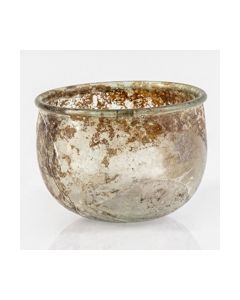 Roman glass beaker
Roman glass beakerSmall glass dating to late Roman Imperial times. From the professor Ritschel collection.
Price: on request Roman bronze theater mask
Roman bronze theater maskMassive piece with great patina. From the Austrian collection of Prof. Ritschel, carrier of the Large Cross of Honor of the Austrian Republic and many other prizes and honors.
Price: on request Roman blue glass bowl
Roman blue glass bowlThe small storage vessel impresses with its beautiful cobalt blue colour. It was made in the 1st century, probably in Italy.
Price: on request Very high herm with bust of Dionysos
Very high herm with bust of DionysosAn almost identical, however less well preserved herm in on exhibition in the J. Paul Getty Museum. From the Austrian collection of Prof. Ritschel, carrier of the Large Cross of Honor of the Austrian Republic and many other prizes and honors.
€2,950 Hellenistic or Roman jar
Hellenistic or Roman jarBody decorated with grooves and dense scale pattern. From the Austrian collection of Prof. Ritschel, carrier of the Large Cross of Honor of the Austrian Republic and many other prizes and honors.
Price: on request Conoid glass vessel
Conoid glass vesselSmall flask from beautiful glass. From the professor Ritschel collection.
Price: on request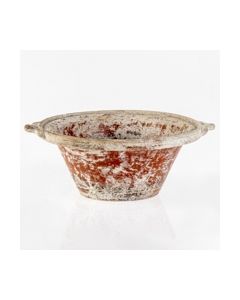 Perfectly preserved Terra Sigillata bowl
Perfectly preserved Terra Sigillata bowlInteresting bowl with decorative handles. Worth the exhibition in a museum. From the Austrian collection of Prof. Ritschel, carrier of the Large Cross of Honor of the Austrian Republic and many other prizes and honors.
Price: on request Elegant roman glass beaker
Elegant roman glass beakerSpherical small glass from Roman Imperial times. From the professor Ritschel collection.
Price: on request Roman glass beaker
Roman glass beakerWell preserved small glass dating to late Roman Imperial times. From the professor Ritschel collection.
Price: on request Roman glass beaker
Roman glass beakerNice pale green glass dating to Roman Imperial times. From the professor Ritschel collection.
Price: on request Roman glass flask
Roman glass flaskFlask with voluminous body from the Late Roman period. A piece from the professor Ritschel collection.
Price: on request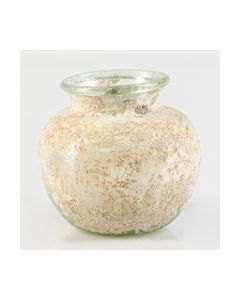 Spherical roman glass jar
Spherical roman glass jarThe small glass from Roman Imperial times is a jar or beaker. From the professor Ritschel collection.
Price: on request Roman glass flask
Roman glass flaskFlask with voluminous body from the Late Roman period. A piece from the professor Ritschel collection.
Price: on request Roman glass bottle with handle
Roman glass bottle with handleWonderful perfectly preserved glass vessel from the Roman Imperial period. 1st to 2nd century AD.
Price: on request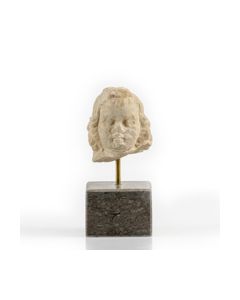 Hellenistic or Roman marble head of Eros
Hellenistic or Roman marble head of ErosFrom the Austrian collection of Prof. Ritschel, carrier of the Large Cross of Honor of the Austrian Republic and many other prizes and honors.
Price: on request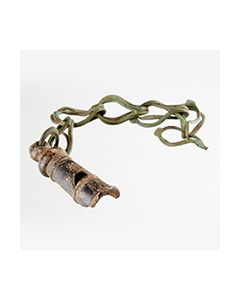 Roman military whistle
Roman military whistleHistorically interesting example of Roman military equipment. Whistles of this type have been used in the 1st to 2nd cent. AD. Their function is not fully understood, yet.
Price: on request Roman military whistle
Roman military whistleHistorically interesting example of Roman military equipment. Whistles of this type have been used in the 1st to 2nd cent. AD. Their function is not fully understood, yet.
Price: on request Very large figure of Aphrodite or Venus Anadyomene
Very large figure of Aphrodite or Venus AnadyomeneVery impressive, 42 cm high figure. The goddess is rising from the sea, holding her tresses and accompanied by an Eros standing on a vase and a dolphin. From the Austrian collection of Prof. Ritschel, carrier of the Large Cross of Honor of the Austrian Republic and many other prizes and honors.
Price: on request Large terra cotta figure of Aphrodite or Venus Anadyomene
Large terra cotta figure of Aphrodite or Venus AnadyomeneVery impressive, 27 cm high figure. The goddess is rising from the sea accompanied by a dolphin, holding her tresses and leaning on a high herm. From the Austrian collection of Prof. Ritschel, carrier of the Large Cross of Honor of the Austrian Republic and many other prizes and honors.
Price: on request

